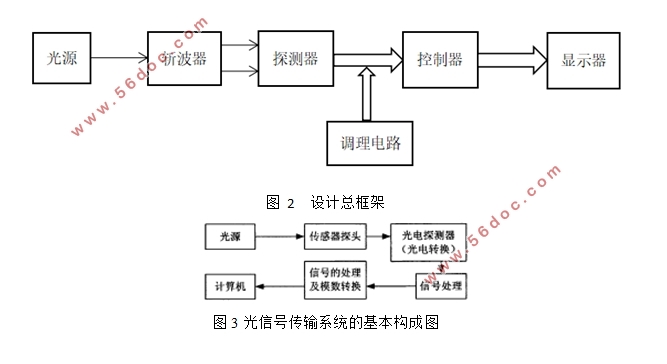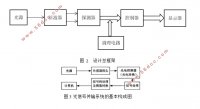分时多频光信号的合成与解调
来源:56doc.com 资料编号:5D26800 资料等级:★★★★★ %E8%B5%84%E6%96%99%E7%BC%96%E5%8F%B7%EF%BC%9A5D26800
资料以网页介绍的为准,下载后不会有水印.资料仅供学习参考之用. 密 保 惠 帮助
资料介绍
分时多频光信号的合成与解调(论文13000字)
摘要;随着光信号解调的日益发展,已经应用到很多领域。本论文中首先阅读和了解一些基本的光信号解调的理论知识以及快速傅里叶变换的基本理论,初步设计了结构相对比较简单而且比较容易实现的分时多频光信号的合成与解调的系统,根据分时多频光信号的合成与解调系统的需要首先以光源和光探测器以及光斩波器为主设计来实现本次设计的光路设计部分以及光路部分的电路设计,其次利用单片机对信号完成了A\D转换,完成了模拟信号之后利用快速傅里叶变换对信号进行计算和处理,最后用液晶显示器显示结果;
关键词:傅里叶变化;调制;解调;单片机;
Synthesis and demodulation of time-sharing multi-frequency optical signals
Danzengciren
NUIST, nanjing 20141388007,China
Abstract;With the increasing development of optical signal demodulation, it has been applied to many fields. In this dissertation, we first read and understand some basic theoretical knowledge of optical signal demodulation and the basic theory of fast Fourier transform, and preliminarily design the synthesis and demodulation of time-divided multi-frequency optical signals with relatively simple structure and relatively easy implementation. The system, based on the requirements of the synthesis and demodulation system of time-division multi-frequency optical signals, first uses the light source, the photodetector, and the optical chopper as the primary design to realize the optical path design part and the circuit design of the optical path part of this design, and then uses The MCU completed the A/D conversion of the signal. After the analog signal was completed, the FFT was used to calculate and process the signal. Finally, the result was displayed on the LCD display.
Key words;Fourier Transform;modulation;demodulation;MCU;

目 录
摘要 4
Abstract 5
1.引言 6
1.1课题的目的和意义 6
1.2光信号解调技术发展及简述 6
2.设计原理与方案 7
2.1 光信号的调制原理 7
2.2 光信号解调系统的原理 8
2.3 快速傅立叶变换 9
3.4方案设计 9
3.硬件设计 10
3.1主要器件的选型 10
3.1.1发射端 11
3.1.2接收器 11
3.2 控制器 12
3.3发射端光路电路设计 13
3.4接收端电路设计 14
3.4.1光电转换电路 14
3.4.2 信号调理电路 15
3.4.3控制电路 15
4.软件设计 17
4.1 软件设计的流程 17
4.2 功能程序 18
4.2.1 A/D转换 18
4.2.2液晶显示屏(LCD) 19
4.2.3快速傅立叶变换(FFT) 20
5.调试与小结 22
5.1 硬件系统搭建过程 22
5.2 软件操作方法及主要结果 23
5.2.1 信号电压调试 23
5.2.2 实际频率分时测试 24
5.2.3 频率混叠和滤波效果 25
5.2.4 实际使用效果 25
6.结论 26
参考文献 27
致谢 28
|



